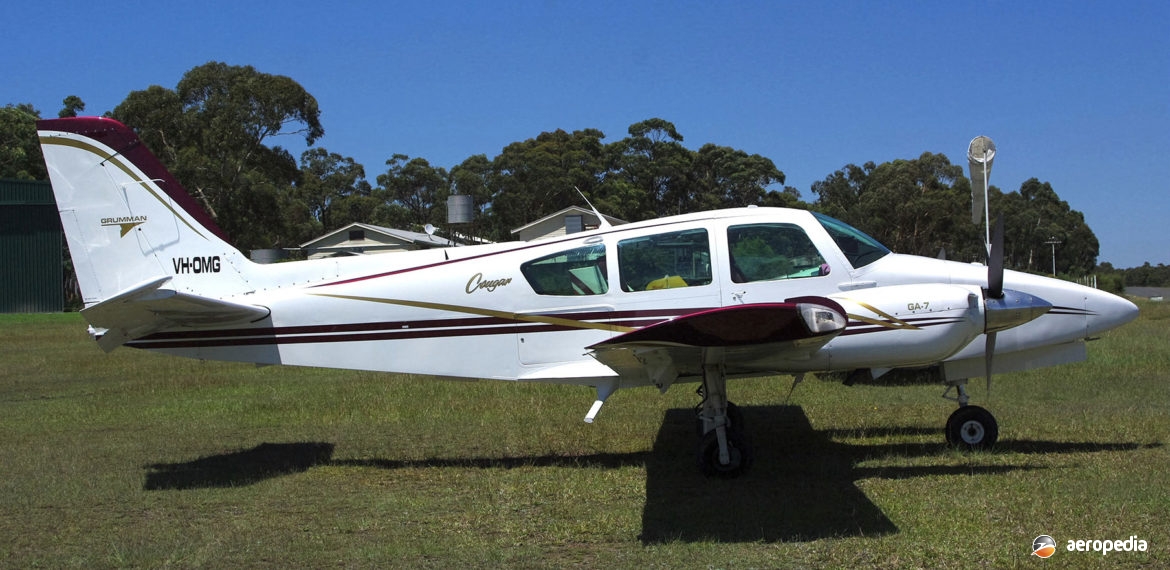Photograph:
Grumman GA-7 Cougar VH-OMG (c/n 008) at Wedderburn, NSW in February 2012 (David C Eyre)
Country of origin:
United States of America
Description:
Four-seat light twin-engine cabin monoplane
Power Plant:
Two 119 kw (160 hp) Avco Lycoming O-320DID four cylinder horizontally-opposed air-cooled engines
Specifications:
- Wingspan: 11.23 m (36 ft 10½ in)
- Length: 9.1 m (29 ft 10 in)
- Height: 3.16 m (10 ft 4 in)
- Wing area: 17.1 m² (184 sq ft)
- Max speed at sea level: 311 km/h (193 mph)
- Max cruising speed at 2,590 m (8,500 ft): 296 km/h (184 mph)
- Economical cruising speed: 259 km/h 161 mph)
- Initial rate of climb: 351 m/min (1,150 ft/min)
- Service ceiling: 5,305 m (17,400 ft)
- Range at max cruising speed with 45 mins reserve: 1,584 km (984 miles)
- Max range: 1,937 km (1,204 miles)
- Empty weight: 1,174 kg (2,588 lb)
- Loaded weight: 1,724 kg (3,800 lb)
History:
The Grumman GA-7 Cougar was an intermediate design between high-performance, single engine, light aircraft and the then current light twins. Designed and developed by the Grumman American Company, production was carried out by Gulfstream American, the prototype being flown for the first time on 20 December 1974, the first production aircraft following on 12 January 1977.
Considerable re-engineering took place following testing of the initial prototype. The fuselage was widened, a cabin door replaced the sliding hood, inward rather than outward retraction of the undercarriage was installed, and a ‘wet’ wing was introduced. After some little time there was some criticism of the engine-out performance of the aircraft and the Company proposed two new models, one with turbocharged 119 kw (160 hp) engines, and another with 134 kw (180 hp) normally-aspirated engines, but neither came to fruition.
Icarus Aviation, which was for some time the Australian agent for the type, commenced importing a number of examples in 1979. The first to be registered was VH-IFX (c/n 0022), which later became ZK-JRV, and later again ZK-CGR in New Zealand. More followed, including VH-MZC (c/n 0070), VH-WPW (c/n 0039), VH-WPX (c/n 0104), VH-MZE (c/n 0112), and VH-BDP (c/n 008 – ex ZK-FSB, 9V-BLA), which later became VH-OMG. Registration of this aircraft was again changed on 14 November 2017 to VH-MJD³.
Further registrations allotted to the type in New Zealand have included ZK-SSS (c/n 0084), which later became ZK-TAD, and later again became ZK-PAP.
In November 2019 two Australian examples, VH-MJD (c/n 0088) and VH-WYW (c/n 0097), were exported to Tonga.
Like other aircraft in the Company’s range, much use was made of metal-to-metal bonding construction techniques throughout, as well as high strength honeycomb aluminium sandwich slabs. Whereas its competitors, the Beechcraft Duchess and the Piper Seminole, were fitted with 134 kw (180 hp) engines, the Cougar was fitted with 119 kw (160 hp) engines, due to their proven reliability and the 2000 hours specified between overhauls.
Seating in the Cougar was for four but the cabin was designed to accommodate six, should the manufacturer have required this feature in future. The type was produced in two models, the GA-7, being the basic aircraft, and the GA-7 Cougar with more comprehensive avionics and improved interior fittings. In 1979 manufacture of the GA-7 series ceased after 115 examples had been completed, Gulfstream American ceasing production of all its piston-engined light aircraft at that time.
In 1989 rights to the manufacture of the type were obtained by American General Aircraft in Mississipi, but none are known to have been built.
In 1991 it was announced that the Tbilisi Aircraft Manufacturing Association in the Republic of Georgia would commence production but nothing more happened until 1995 when Socata in France purchased manufacturing rights to the type, to be known as the TB-320 Tangara.
In 1996 it was proposed to redevelop the GA-7 Cougar it as the TB-360 with 134 kw (180 hp) Lycoming O-360 engines and three prototypes were built to the new configuration. However, due to the company’s commitments to other work, production of the new type was shelved until 2000, at which time it was expected to be fitted with a new Morane-Renault engine.

